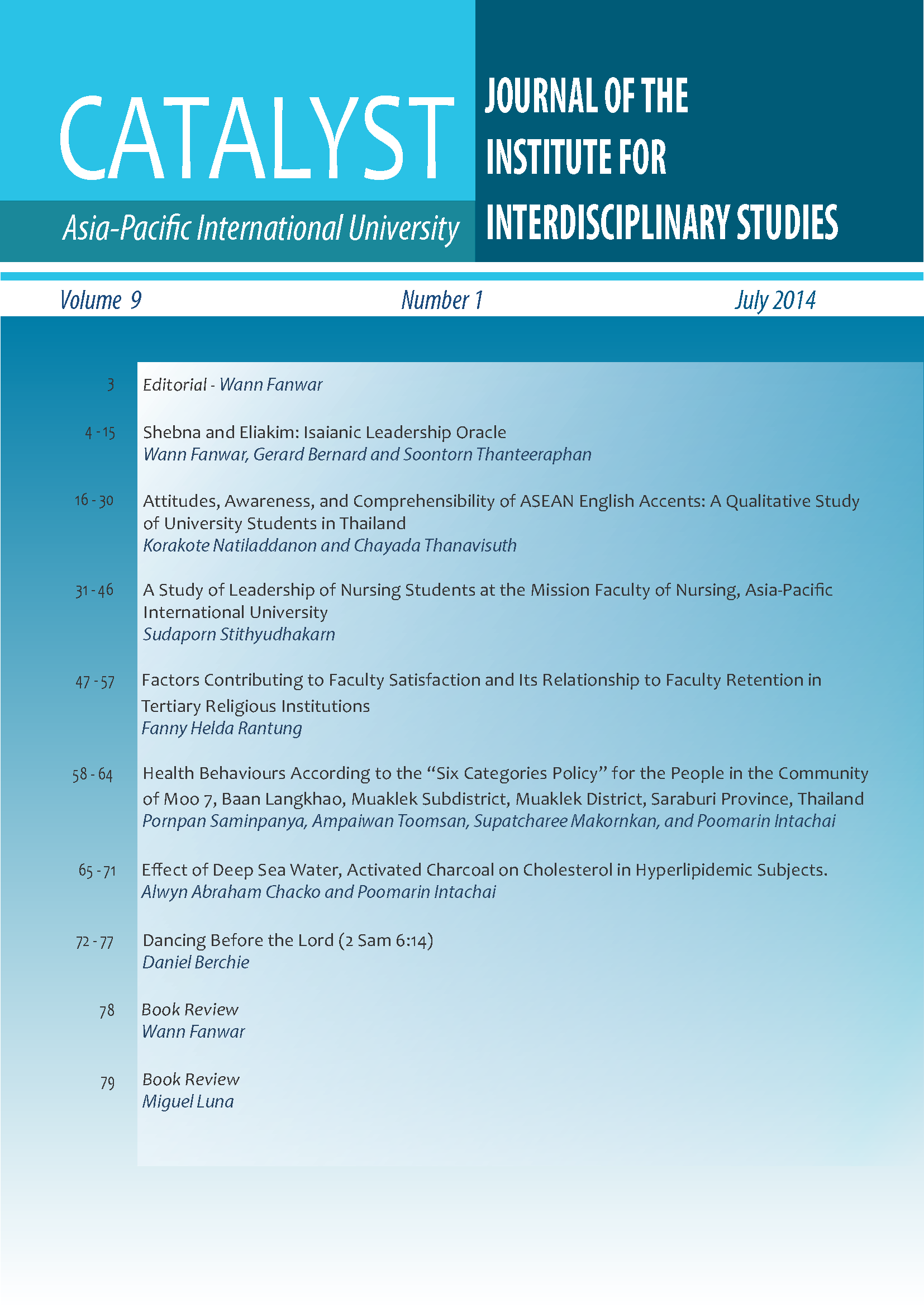Determining the Effectiveness of Three Teaching Methods for Blood Pressure Measurement Skills
Main Article Content
Abstract
The purpose of this study was to examine the effectiveness of the following three methods for teaching blood pressure measurement: 1) lecture, 2) demonstration and 3) self study using video, and to measure the effect of each method on acquired knowledge, skill performance and learning satisfaction of the nursing students at Asia-Pacific International University. The participants of this study were 90 undergraduate nursing students who had never taken the fundamental of nursing courses, in which they were assigned to one of three groups by cluster randomization. This experimental study used a Cognitive learning theory as a conceptual framework ANOVA was used to determine any statistcial significance of knowledge, skill performance and satisfaction after three teaching methods were applied. There was no significant difference between the three teaching methods, though the lab demonstration produced the highest satisfaction score among the three. Nonetheless, a further study with a lar
Article Details

This work is licensed under a Creative Commons Attribution-NonCommercial-NoDerivatives 4.0 International License.
Copyright: Asia-Pacific International University reserve exclusive rights to publish, reproduce and distribute the manuscript and all contents therein.
References
Anukulboot, P. A. (2004). Curriculum and Teaching: Teach to know how to think. Journal of Thai Teacher Association, 1(5), 63-66.
Billings, M. D. & Halstead, A. J. (2005). Teaching in Nursing: A Guide for Faculty. Missouri: Elservier Inc.
Burnard P. (1991). Using video as a reflective tool in interpersonal skills training. Nurse Education Today, 11 : , 143-146.
Carrizo, L., Sauvageot, C. & Bella, N. (2003). Information tools for the preparation and monitoring of education plans. Education policies and strategies 5 by the United Nations Educational, Scientific and Cultural Organization (UNESCO). Retrieved March 25, 2008 from http://unesdoc.unesco.org/ images/0013/001323/132306e.pdf
Cindy, H. (2002). Video Usage and Active Learning Strategies Among Community College Faculty Members. Community College Journal of Research & Practice, 24(5). Retrieved March 20, 2008, from http://0web. ebscohost.com.catalog.llu.edu/ehost/detail?vid=17&hid=109&sid=ba39f7c7-5132-4df6-a132b8a77501335e%40sessionmgr104
Cogo, A. L., Pedro, E. N., Silveira, D. T., Silva, A. P., Alves, R. H., Catalan V. M. (2007). Development and use of digital educative objects in nursing teaching. Revista Latino-Americana de Enfermagem. 15(4). Retrieved March 20, 2008, from http://www.scielo.br/scielo.php?script=sci_arttext&pid=S010411692007000400028&Lng=en&nrm=iso&tlng=en
Eiamla-or, P. (2004). A Construction of Nursing Performance Assessment for Nurse students. Master Project, M.Ed. (Educational Measurement). Bangkok: Srinakarinviroj University.
Halpern, F. D. (1994). Changing College Classrooms: New teaching and learning strategies for an increasingly complex world. California: Jossey-Bass Inc.
Hoban, F.G. (2002). Teacher Learning for Educational Change. Philadelphia: St Edmundsbury Press, Limited.
Jones, A. (2007). Putting practice into teaching: an exploratory study of nursing undergraduates’ interpersonal skills and the effects of using empirical data as a learning resource. Journal of Clinical Nursing, 16: 2297–2307.
Kozier, B, Erb, G., Berman, J. A., & Burke, K. (2005). Fundamentals of Nursing (6th ed.). New Jersey: Prentice-Hall.
Maxwell, C. (1978). Sensitivity and Accuracy of the Visual Analogue scale: A Psycho-physical Classroom Experiment. British Journal of Clinical Pharmacology, 6(1), 15-24. Retrieved April 30, 2008, from http://www.pubmedcentral.nih.gov/picrender.fcgi?artid=1429397 &blobtype=pdf
Munro, H. B. (2005). Statistical Methods for Health Care Research (5th ed.). Philadelphia: Linppincott Williams & Wilkins.
Patiyanee, S. (1998). Measurement in Education (2nd ed.). Karasin: Prasarn Printing.
Pimekrai, M. (2003). Effectiveness of Thai Language learning achievement of Prothom Suksa students by using Storyline Method and the methods in teacher’s manual. Retrieved February 20, 2008, from http:// www.lib.ubru.ac.th/thesis/montian_2546/title.pdf
Polit, D.F, & Beck, C.T. (2006). Essentials of Nursing Research: Methods, Appraisal, and Utilization (6th Ed.). Philadelphia: Lippincott Williams & Wilkins.
Powell, S.S., Canterbury, M.A., & McCoy, D. (1998) Medication administration: does the teaching method really matter? Journal of Nursing Education, 37(6): 281-283.
Salyers, V. L. (2007). Teaching psychomotor skills to beginning nursing students using a web-enhanced approach: a quasi-experimental study. International Jounal of Nursing Education Scholarship, 4(11). Retrieved February 20, 2008, from http://www.ncbi.nlm.nih.gov/sites/entrez
Scanlan, J.M., Care, W.D., & Udod, S. (2002). Unravelling the unknowns of reflection in classroom teaching. Journal of Advanced Nursing, 38(2), 136-143. Retrieved May 4, 2008, fromhttp://0web. ebscohost.com.catalog.llu.edu/ehost/detail?vid=16&hid=109&sid=ba39f7c7-5132-4df6-a132b8a77501335e%40sessionmgr104
Silverman, F. (2006). Learning styles. Retrieved March 2, 2008 from http://0eb.ebscohost.com.catalog.llu. edu/ehost/pdf?vid=30&hid=109&sid=ba39f7c7-5132-4df6-a132-b8a77501335e%40sessionmgr104
Suk, M., Oh, W., & Kil, S. (2006). Guided imagery types on stress and performance of an intramuscular injection of nursing students [Article in Korean]. Taehan Kanho Hakhoe Chi., 36(6): 976-82. Retrieved Febuary 20, 2008, from http://www.ncbi.nlm.nih.gov/sites/entrez
UNESCO (nd.). The six DFA goals. Retrieved April 8, 2008, from http://portal.unesco.org/education/en/ ev.phpURL_ID=53844&URL_DO=DO_TOPIC&URL_S ECTION=201.html
Watcharakul, J. (2003). Training to think critical. Journal of Academic Center, 11(3): 8-11.
Wellard J. S., Woolf, R., & Gleeson, L. (2007). Exploring the Use of Clinical Laboratories in Undergraduate Nursing Programs in Regional Australia. International Journal of Nursing Education Scholarship, 4(1).
Wink, M. D. (1993). Effect of a program to increase the cognitive level of questions asked in clinical postconferences. Journal of Nursing Education, 32(8): 357-363.
Wongphan, T. (2001). Effects of learning by using video symbolic modeling and group discussion on caring behaviors of staff nurses. Thesis (M.N.S.). Bangkok: Chulalongkorn University.Retrieved February 20, 2008, from http://library.car.chula.ac.th:82/search*tha?/dCognitive+learning+ theory/dcognitive+ learning+theory/-3%2C-1%2C0%2CB/frameset&FF=dcognitive+ learning+theory&1%2C1%2C.


